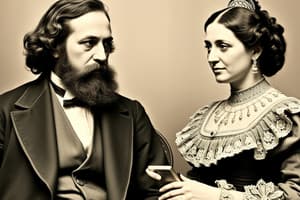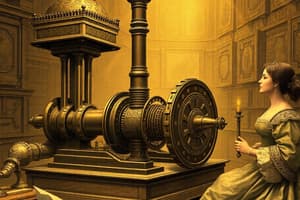Podcast
Questions and Answers
What was Ada Lovelace's unique upbringing influenced by?
What was Ada Lovelace's unique upbringing influenced by?
- Mathematics and poetry
- Science and romanticism (correct)
- Philosophy and history
- Engineering and art
How did Ada Lovelace's mother shape her interests?
How did Ada Lovelace's mother shape her interests?
- By encouraging her to pursue poetry
- By fostering a love for mathematics and science (correct)
- By discouraging her from intellectual pursuits
- By exposing her to music and dance
What method did the Difference Engine use for calculations?
What method did the Difference Engine use for calculations?
- Fractional calculus
- Geometric progression
- Infinite series
- Finite differences (correct)
What key concept did Ada Lovelace's writings on the Difference Engine demonstrate?
What key concept did Ada Lovelace's writings on the Difference Engine demonstrate?
Who attended a gathering where Ada Lovelace and Charles Babbage's intellectual sparks ignited?
Who attended a gathering where Ada Lovelace and Charles Babbage's intellectual sparks ignited?
What setback motivated Babbage to come up with the idea for the analytical engine?
What setback motivated Babbage to come up with the idea for the analytical engine?
What inspired Babbage to repurpose the technology of the jacquard loom for his analytical engine?
What inspired Babbage to repurpose the technology of the jacquard loom for his analytical engine?
What made Lovelace realize the need for software to make the analytical engine versatile enough?
What made Lovelace realize the need for software to make the analytical engine versatile enough?
What did Lovelace publish in 1843 that made her the world's first published computer programmer?
What did Lovelace publish in 1843 that made her the world's first published computer programmer?
Despite her contributions, what characterized Lovelace's relationship with Babbage?
Despite her contributions, what characterized Lovelace's relationship with Babbage?
Study Notes
- Ada Lovelace, a Victorian-era woman, is considered a pioneer in computing and the information age.
- Born into a privileged background, Ada was married to Lord Lovelace, a man who was 10 years her senior.
- Ada had a unique upbringing, with influences from both science and romanticism.
- She was influenced by her father Lord Byron, a famous poet and notorious figure.
- Ada's mother, Annabella, tried to shield her from her father's influence and instilled a love for mathematics and science in her.
- Ada was a prodigy, developing skills in engineering and science from a young age.
- She attended a gathering where Charles Babbage presented his Difference Engine, an intricate calculating machine, which sparked her imagination.
- The Difference Engine used a method called finite differences to break down complex equations into simpler pieces and perform calculations using only addition.
- The machine was capable of calculating mathematical tables with great precision, reducing the risk of human error and making navigation easier.
- Ada's writings, including her work on the Difference Engine, are considered a roadmap for the computer age and demonstrate her visionary thinking.- Charles Xavier De Morgan attended a gathering where Ada Lovelace and Charles Babbage's intellectual sparks ignited, marking the beginning of their lifelong friendship.
- Babbage's plan to build a technologically advanced calculator required state-of-the-art manufacturing and a significant investment.
- The era of extraordinary projects was in full swing, with Brunel proposing the world's first telegraph systems, Darwin transforming understanding of evolution, and Faraday revealing the secret of electromagnetism.
- Babbage shelved his idea for a grand mechanical calculator due to a dispute with his engineer Joseph Clement and an enforced gap in his progression of engine designs.
- Inspired by this setback, Babbage came up with the idea for an analytical engine, which would later be the legacy of Ada Lovelace.
- The analytical engine was an audacious machine, designed to be 15 feet high and 6 feet in diameter, capable of storing an unlimited memory, and featuring conditional branching capabilities.
- Babbage's sketches of the analytical engine included plans for a steam engine and thousands of variables, illustrating the machine's immense size and complexity.
- Lovelace's fascination with the capabilities of the analytical engine led her to realize the need for software to make it versatile enough to calculate various types of equations.
- Sidney Padua was drawn to the story of Babbage and Lovelace after creating a brief biography of Lovelace, admiring their personalities and the era in which they lived.
- The jacquard loom, a state-of-the-art device that automated weaving, inspired Babbage to repurpose the technology to control his new analytical engine, leading to the concept of conditional branching.
- The punch card technology in the jacquard loom represented a binary system, and Lovelace saw the potential for it to work with the analytical engine, making it the world's first binary machine.
- Lovelace spent years absorbing the math needed to demonstrate the analytical engine's capabilities, ultimately publishing the world's first computer program in 1843.
- Lovelace's notes on the analytical engine show her understanding of how to unlock its full potential and extend its capabilities beyond Babbage's initial vision.
- Despite her contributions, Lovelace's relationship with Babbage was unequal, with him as the lecturer and her as the student. However, she did manage to turn the tables in 1842 when promoting his machine.
- Lovelace's translation of Menabrea's article on the analytical engine led to her formulating thoughts on its computational possibilities and writing a program for the new e numbers.
- Lovelace's publication of the first computer program in 1843 made her the world's first published computer programmer, but her real contribution lies in her understanding of the computing machine's potential.
- In the face of disagreements over government funding for the analytical engine, Babbage's irascible personality and past financial mismanagement made it difficult for him to secure the necessary funds to build the machine.- Ada Lovelace had a plan to secure funding for Charles Babbage's analytical engine in the 1840s.
- She wrote a letter to Babbage proposing to manage the business aspect of the project, as he was solely focused on building it.
- Babbage refused her conditions and relinquishment of control, which led to a strained relationship.
- Lovelace, passionate about the engine and its potential, brought up the idea of gambling as a way to raise funds, thinking mathematically and logically about the odds.
- She was part of a gambling syndicate that included wealthy men like Chapel Nightingale, possibly Florence Nightingale's father, and Johnny Cross, the son of an electrical scientist.
- Lovelace owed significant gambling debts, leading to her confessing to her mother before her death in 1852.
- She was just 36 years old when she died, leaving behind a life filled with regret and her extraordinary manifesto largely forgotten.
- In her dying wish, she requested to be buried next to her father, Lord Byron, despite her strained relationship with him.
- Ada Lovelace's work on the analytical engine was largely forgotten until the 1940s when Alan Turing took interest in her ideas and saw the potential of mechanized thought.
- Turing, a pioneer in computer science, was fascinated by the idea of machines understanding and acting upon instructions and designed the Bomb, a significant machine for cracking encrypted messages.
- Lovelace's contribution to computer science wasn't fully recognized until the 20th century, but she saw the potential for computers in ways her peers didn't, nearly two centuries before they became ubiquitous in the modern world.
Studying That Suits You
Use AI to generate personalized quizzes and flashcards to suit your learning preferences.
Description
Test your knowledge on Ada Lovelace, a Victorian computing pioneer, and her work with Charles Babbage's analytical engine. Learn about her contributions to computer science and her visionary thinking ahead of her time.




